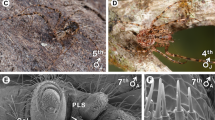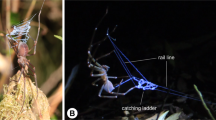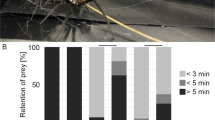Abstract
Arising from: S. N. Gorb et al. Nature 443, 407 (2006)10.1038/443407a; Gorb et al. reply
As with all spiders, tarantulas spin silk from specialized structures in the abdomen called spinnerets, which are key features unique to the group. Recently Gorb et al.1 reported that the zebra tarantula Aphonopelma seemanni also secretes silk from its feet, which might improve its ability to climb on vertical surfaces. Here we show that when the spinnerets are experimentally sealed, the zebra tarantula cannot secrete silk or similar threads, disagreeing with previous reports by Gorb et al.1. Additional evidence also disagrees with leg secretion of silk.
Similar content being viewed by others
Main
We placed four specimens of A. seemanni each in separate glass containers with the floor and two vertical walls covered with 20 microscope slides. Tarantulas remained in the container for 14 h, after which the slides were carefully examined. Seventy-two hours later, we sealed the spinnerets of the same individuals with paraffin and repeated the experiments. In the first trials with free spinnerets most slides (24 out of 40 horizontal slides and 16 out of 40 vertical slides) showed silk threads together with dislodged abdominal urticating hairs. None of the slides in the trials with sealed spinnerets showed silk threads; we found only urticating hairs. In both series of trials we observed the spiders walking on vertical surfaces. In addition, we made transverse cuts of A. seemanni tarsi and no structures interpretable as silk glands or silk conduits were observed.
Tarantulas entangle silk threads from the spinnerets with their tarsi (Fig. 1). They often use hind legs to entangle silk, but we also observed A. seemanni entangling with their other legs. This behaviour might explain the presence of the thread footprints photographed by Gorb et al.1. Tarantula silk released from spinnerets consists of multiple, roughly parallel silk threads which are better observed when magnified. This pattern could be maintained once the silk line is adhered to the substrate, when combed or stepped by tarsal scopulae. Tarsal structures interpreted as spigots by Gorb et al.1 are very different from the diverse kinds of spigot reported for spiders2,3,4. We found that the structures reported by Gorb et al.1 are very similar in morphology and size to fragments of tarsal thermosensory setae reported for other tarantulas5. In insects, a common origin or convergence was proposed for silk spigots and sensory setae6,7. The presence of conspicuous, dense scopulae with spatulated setae on the ventral surface of tarsi and metatarsi of all tarantulas seems incompatible with the presence of spinning spigots in a lower layer, because scopula setae might interfere with silk release. Furthermore, it has been explained that in A. seemanni the friction with scopula setae is enough to guarantee spider climbing8.
Arrows indicate the silk thread.
During our observations, individuals of A. seemanni brushed spinnerets with their hind-leg tarsi while walking and releasing silk threads. The presence of abdominal urticating hairs with silk is indicative of this brushing. We did not find evidence of silk-like secretion through leg structures in tarantulas.
References
Gorb, S. N. et al. Silk-like secretion from tarantula feet. Nature 443, 407 (2006)
Bond, J. E. Setae-spigot homology and silk production in first instar Antrodiaetus unicolor spiderlings (Araneae: Antrodiaetidae). J. Arachnol. 22, 19–22 (1994)
Coddington, J. A. Spinneret silk spigot morphology: evidence for the monophyly of orbweaving spiders, Cyrtophorinae (Araneae), and the group Theridiidae plus Nesticidae. J. Arachnol. 17, 71–95 (1989)
Griswold, C. E., Ramírez, M. E., Coddington, J. A. & Platnick, N. I. Atlas of phylogenetic data for entelegyne spiders. Proc. Calif. Acad. Sci. 56, 1–324 (2005)
Raven, R. J. A new tarantula species from northern Australia (Araneae, Theraphosidae). Zootaxa 1004, 15–28 (2005)
Ross, E. S. In The Insects of Australia 405–409 (Camberra & Melbourne Univ. Press, 1991)
Merrit, D. J. The organule concept of insect sense organs: Sensory transduction and organule evolution. Adv. Insect. Physiol. 33, 192–241 (2007)
Niederegger, S. & Gorb, S. N. Friction and adhesion in the tarsal and metatarsal scopulae of spiders. J. Comp. Physiol. A 192, 1223–1232 (2006)
Author information
Authors and Affiliations
PowerPoint slides
Rights and permissions
About this article
Cite this article
Pérez-Miles, F., Panzera, A., Ortiz-Villatoro, D. et al. Silk production from tarantula feet questioned. Nature 461, E9 (2009). https://doi.org/10.1038/nature08404
Received:
Accepted:
Issue Date:
DOI: https://doi.org/10.1038/nature08404
This article is cited by
-
Giant steps: adhesion and locomotion in theraphosid tarantulas
Journal of Comparative Physiology A (2021)
-
Gorb et al. reply
Nature (2009)
Comments
By submitting a comment you agree to abide by our Terms and Community Guidelines. If you find something abusive or that does not comply with our terms or guidelines please flag it as inappropriate.




